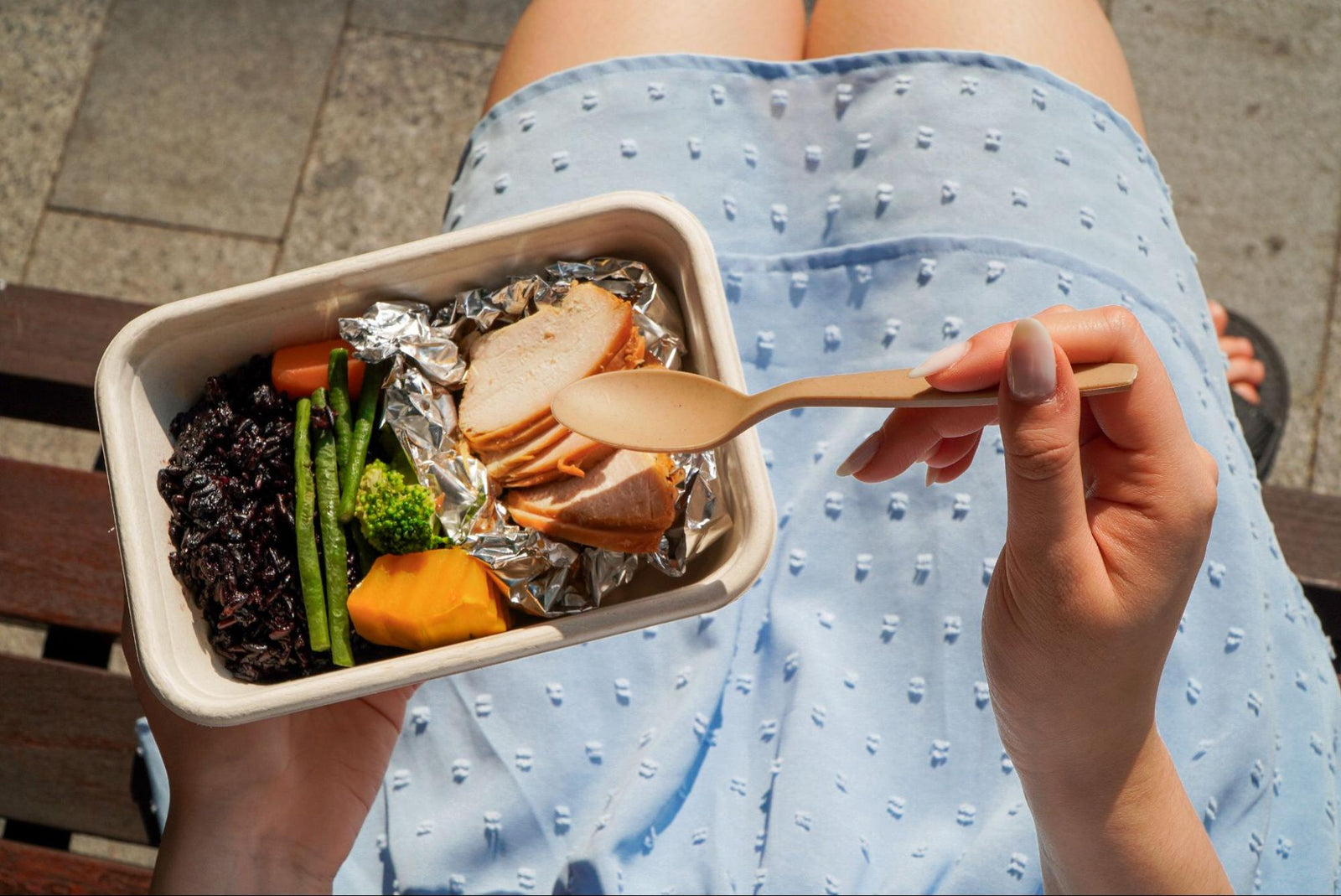As compostable packaging gains more attention, so does the confusion around its sustainability, how to choose the right type, and how to differentiate it from other packaging options. In this article, we will dive deeper into the world of compostable packaging and explore what we can expect as the world increasingly shifts toward this eco-friendly solution.

What is Compostable Packaging, and Why More People Should Pay Attention to It?
Compostable packaging is a form of packaging made from various natural materials such as sugarcane, corn starch, potato starch, and wood pulp. It is a popular sustainable packaging option because microorganisms can break down compostable materials into compost, a valuable fertilizer that enriches plants and soil. This helps reduce a large portion of plastic pollution by driving it away from waterways and landfills.
Compostable packaging is gaining popularity and is being promoted as a key solution to combat plastic waste and build a circular economy for plastics. However, many people mistakenly believe that compostable packaging can be discarded freely, much like plant compost. In reality, it must be separated from other waste for proper processing and disposal.
Typically, compostable packaging can only biodegrade and decompose in a commercial composting facility, which requires high temperatures above 55°C to accelerate the degradation process. Unfortunately, there are very few facilities like this and they are often located in industrial complexes. On the other hand, home composting can be done in your backyard or home garden, but it is not suitable for most compostable packaging.
Here’s Why Consumers Care About Compostable Packaging:
1. The Increasing Awareness of Sustainability Since the Pandemic
During the COVID-19 lockdown, the market experienced significant growth in volume and improved earnings due to an increase in the consumption of packaged food and a growing consumer preference for compostable packaging over plastic packaging.
A survey by compostable flexible packaging company TIPA revealed that COVID-19 has shifted consumer perception towards plastic packaging. Despite the economic ramifications of the pandemic, around 85% of consumers believe compostable packaging should replace conventional food packaging, and about 58% are willing to pay more for it.
Moreover, various governments are easing regulations in the packaging industry to facilitate and regulate the supply of raw materials. As a result, in the post-COVID period, the demand for compostable packaging is expected to rise moderately due to its benefits, such as being lightweight, portable, and easy to carry, along with consumers continuing to adhere to safety regulations.

2. Awareness of Packaging Waste in Oceans and Landfills
Public awareness of packaging waste, particularly plastic waste leaking into the environment, has reached an all-time high in recent years. Striking images of ocean plastic pollution have deeply affected sentiment worldwide, leading to a growing demand for more sustainable practices from brand owners and retailers. According to a report by Boston Consulting Group, nearly half of consumers are now avoiding what they consider "harmful" packaging, with 68% associating plastic with ocean pollution.
Packaging waste is not confined to the ocean; it's all around us. Whether at home, in the workplace, or in local businesses, packaging waste is everywhere. Despite our best efforts, it has become a common sight in both personal and commercial settings, as the economy relies on surplus materials to sustain commercial systems.
Here are some examples of packaging waste you might encounter daily, just to name a few:
- Plastic food wrappers, such as those from granola bars and candy bars
- Dry food packaging and containers, like cereal boxes and snack containers
- Takeout containers, including paper bags, food tins, and condiment cups
- Shipping materials, like styrofoam, plastic wrap, and bubble wrap
- Plastic waste from household product containers, like dish soap and laundry detergent bottles.

3. They Care About Future Generations
More consumers are taking future generations into consideration while making their decisions. The current climate crisis has made the consumer think more carefully in buying products and choosing companies or brands that are more sensitive to the environment.
With the increasing consumer demand for biodegradable and compostable products, companies are developing and sourcing eco-friendly packaging to satisfy their customers and improve the world.
Challenges Business Face When Switching to Compostable Packaging
Another significant challenge is the higher cost of sustainable packaging compared to conventional options. This is due to the materials involved and their sourcing—whether new or recycled—as well as the less-established supply chains, manufacturing processes, and lower economies of scale. However, by supporting these businesses, we can collectively help reduce the cost of compostable packaging.
Businesses should be transparent about their packaging processes and encourage customers to support the full lifecycle of their products.
EQUO products are made from natural materials, and can biodegrade within 3-6 months:
Plant-based Straws: Made from coffee, bagasse, coconut, grass, and rice, these straws are safe for health and completely compostable in the natural environment.
Compostable Food Containers: Made from sugarcane bagasse, a sustainable and renewable natural resource that decomposes quickly. Bagasse fiber is durable, flexible in packaging, breathable, and waterproof.
Compostable Utensils: Made from sugarcane fibers and coffee grounds, these spoons, forks, and knives are elegant, durable, and fully compostable in the environment. They are an excellent choice for eco-friendly and durable tableware sets.
Paper cups and lids with water-based coating: These cups use a water-based coating instead of plastic (PP, PE, or PLA), reducing carbon dioxide (CO2) emissions during production and minimizing environmental impact during decomposition compared to regular paper cups. They completely decompose in the natural environment within 18 weeks and come in various sizes, making them suitable for a wide range of uses.

Conclusions
In addition to packaging, the products we consume play a crucial role in environmental conservation. Opting for eco-friendly choices, such as renewable energy sources, organic food, and sustainable clothing, helps reduce our carbon footprint. By supporting businesses that prioritize sustainability and environmentally-friendly practices, we contribute to preserving natural resources and promoting a healthier planet for future generations.
Nature's beauty is undeniable, and it is our duty to cherish and protect it. Advocating for eco-friendly packaging and products, reducing pollution, conserving resources, and preserving natural habitats are essential steps toward a sustainable future. We must recognize the impact of our actions on the environment and the well-being of all living beings. Through collective action and collaboration, we can create a harmonious coexistence with nature, ensuring a world that future generations will be proud to inherit.


